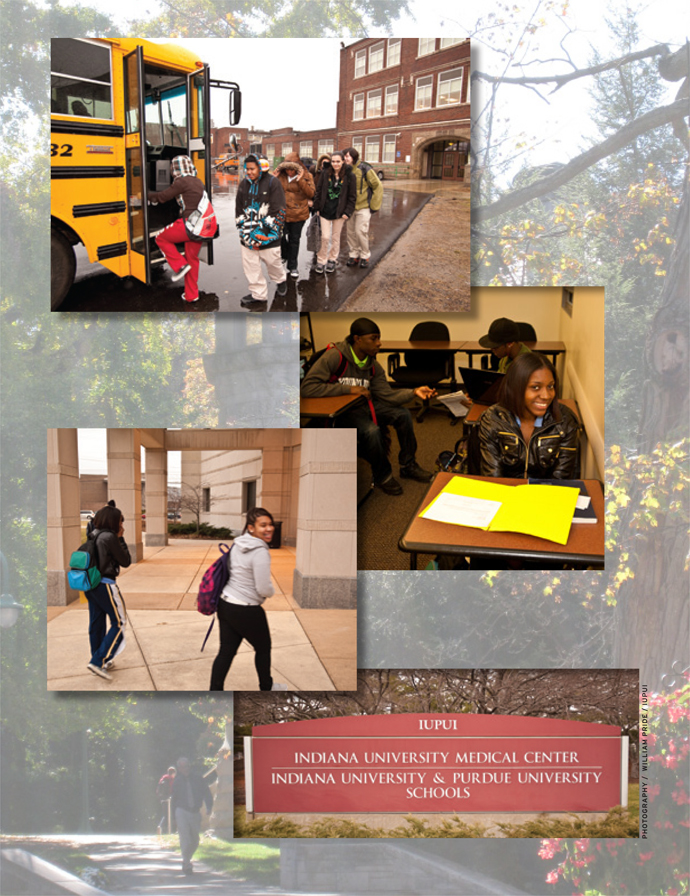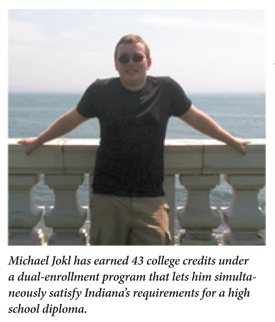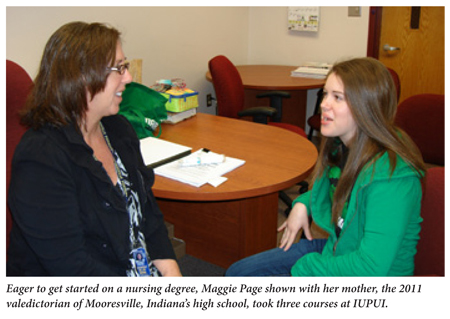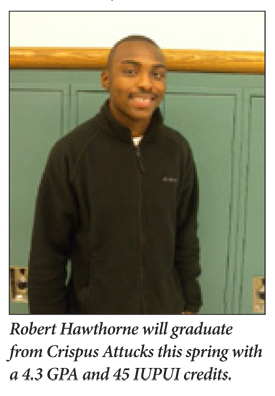Michael Jokl enrolled in an algebra class at Indiana University-Purdue University Indianapolis when he was a 14-year-old 8th-grade home schooler. Four years later, he has earned 43 college credits under a dual-enrollment program that lets him simultaneously satisfy the state’s requirements for a high school diploma. He holds a 3.9 grade-point average at the university, which is known as IUPUI; he has completed an entire freshman-year college curriculum and has taken all the math he’ll need toward an engineering degree.
Now he’s “applying to the Ivies” to complete his undergraduate degree, he says.
A century ago, often under pressure from labor unions, states passed seat-time and mandatory-attendance laws that compelled youngsters to stay in school, and out of the competition for jobs. The laws haven’t changed much today, but kids have, and by their midteens, many of them—bored with high school or academically beyond it—are ready for the next step.
The states’ almost uniform response has been dual-enrollment programs. Kids remain in high school but are able to take college courses at the same time. Almost every state has some sort of dual-enrollment policy, and 12 states require their school districts and public postsecondary schools to work out dual-enrollment partnerships, according to the Education Commission of the States (ECS). The U.S. Department of Education reported in 2005 that 98 percent of community colleges and 77 percent of public four-year colleges were taking part in dual-enrollment programs.
Universities and private colleges have long accepted gifted students and ambitious high schoolers under all sorts of arrangements. Among other reasons, colleges have viewed dual enrollment as a way to recruit and retain the brightest young students in the area. But in 1985, starting in Minnesota, states began looking at dual enrollment as a way to prepare even average students for college and to move nonacademic-minded kids into career and technical education. Some 5,300 high schoolers attended classes at 65 public, private, technical, community, and extension campuses under Minnesota’s Post-Secondary Enrollment Options Program in 2008–09, it reported on its web site.
Today, as legislators see it, dual enrollment offers something for everyone: academic enrichment for kids who have maxed out the honors and accelerated classes their schools offer; a glimpse of college rigor for high school laggards; and a leg up on a career for those who enroll in trade programs. Not incidentally, dual enrollment promises to speed youngsters through college and into the workforce, cutting college costs for parents and taxpayers alike.
But in their rush to get high schoolers into college, legislators are setting some up for disappointment. With state education budgets perpetually strapped, many states haven’t provided money to pay the college tuition. That leaves youngsters and their parents to pick up the bill, or high schools and colleges to swallow the cost.
Under federal law, youngsters who don’t have a high school diploma can’t apply for student loans, grants, and scholarships. Michael Jokl is paying his own tuition—$1,100 per calculus course—by mentoring fellow math students, grading papers for a math professor, and, on weekends, babysitting. He has a 25-mile one-way commute, is on campus daily from 9 AM to 3 PM, and then goes home to finish work on his home-school curriculum.
The Ivies, he says, may in some ways be easier than high school.
The Talented Tenth
Standardized test scores suggest that the country’s brightest youngsters are stuck in an academic rut: The 2009 National Assessment of Educational Progress shows that reading and math scores for the brightest 10 percent of 12th graders have barely budged in the past five years. Still, there’s evidence that many kids are eager for a challenge, and more than up to it (see “Challenging the Gifted,” features, Spring 2011). Sixteen percent of last year’s SAT takers had crammed more than four years of math into high school and 10 percent took more than four years of natural science.
About 240,000 youngsters in grades 4 through 8 take part in university-sponsored talent searches each year. As early as 7th grade, students may take a college-entrance exam in hopes of gaining access to college-level enrichment programs. Of the 67,000 7th graders who took the exams at Duke University’s Talent Identification Program last year, 50 earned the highest possible score on one or more sections of the SAT or ACT. More than 4,200 kids who were in 8th grade or lower took the College Board’s Advanced Placement (AP) exams in 2010; 22 percent of them scored a five, the highest possible score.
When academic challenges are available, “students are taking advantage of them,” says Martha Putallaz, executive director of Duke’s talent program, which has added new summer programs to meet the demand, and still has a waiting list of more than 1,000 kids.
There are probably several reasons for all of this, including the competition for college admission and scholarships. But Dr. Putallaz and others also blame federal and state policies that pressure schools to concentrate their resources on getting children to minimal math and reading competencies. That means high school is often a fairly dismal place for faster learners.
One day last December, I visited Mooresville High School, a half-hour’s drive west of Indianapolis and firmly in farm country, to meet Maggie Page, who has a 4.0 grade-point average and will be the school’s 2011 valedictorian. Debra Page, Maggie’s mother and Mooresville High’s guidance counselor, sat with us. Mooresville seemed to me to offer lots of options for ambitious learners, including AP courses in seven subjects. Teachers from Ivy Tech, the statewide community college, teach psychology, sociology, and math in the evening. Mooresville High faculty who have been certified by Indiana University at Bloomington to teach the IU curriculum offer four history and English courses. Ivy Tech has certified Mooresville teachers in two English classes.
Still, eager to get started on a nursing degree, Maggie took three courses through SPAN (IUPUI’s Special Programs for Academic Nurturing) beginning in 10th grade and earned a 4.0 on those, too. As we talked, Maggie, who is 18, rolled her eyes at the suffusive busy work and rules of high school, and at the minimal challenge of many classes. “I’m only learning in a few of my classes,” she said.
Debra Page agreed with her daughter about the lack of challenge for the school’s brightest students. “We do them a disservice,” she said.
IUPUI started its dual-enrollment program in 1984 when the director of the university’s honors programs opened liberal arts classes to gifted and talented kids. Since then, the university—which is a health-sciences partnership between Indiana and Purdue—has opened all of its undergraduate schools to the most able youngsters and claims to be the only Indiana university that does.
SPAN enrolls about 200 youngsters each semester and 300 in total each year. Most are high school seniors, but this year there also are two 13-year-olds and a 9-year-old who’s taking second-year physics. Most are boys: “Girls want to stay at high school with their friends,” says Dr. Johnny Russell, SPAN’s executive director. Half are home schoolers; the other half come from 61 area private and public schools, mostly in the suburbs. Kids typically take only a course or two per year, but three youngsters have earned more than 80 academic credits, or enough to make them second-semester juniors when they eventually enroll as undergraduates.
Growing up in central Indiana, Russell says he was “one of those kids they didn’t know what to do with,” too precocious for his tiny school district to accommodate, but kept in high school by state laws that typically require kids to sit through 40 or so courses to graduate. Accountability measures and stretched school budgets are only making things tougher for the brightest kids, he adds. School curricula “shoot for the middle,” and school resources increasingly are spent getting struggling students just to average. “The upper 2 percent, they’re falling by the wayside,” he says. They’re bored, they dread school, they’re often discipline problems, “their academics begin to stagnate and stall.”
Russell talks about “the glimmer of hope” that youngsters experience when they come to SPAN, and “the excitement, the zeal” they feel when they get to do college work. The youngsters I spoke with didn’t put it quite that colorfully, but they did speak of the satisfaction of knowing they were learning and were doing what they called “productive” work.
SPAN requires the youngest students to show some evidence of giftedness: IQ or SAT scores, participation in talent-search programs, recommendations from teachers or IUPUI professors. But even then, Russell turns down some who aren’t socially ready for college. “This is not a proving ground,” he told me. “If they fail here, it will haunt them.”
Entrance criteria are grades, not college-entrance exam scores, for older kids: Russell’s standard is “As, some Bs, no Cs.” Home schoolers take the ACT to qualify. And everyone must maintain a 3.3 IUPUI grade average to stay in SPAN.
Russell places no more than two SPAN youngsters in any IUPUI class: “If there are three of them, they huddle together,” he says. He gets concurrence from the professor before assigning a particularly young child to a class, but faculty otherwise aren’t told when they’re teaching, say, an 11th grader.
One afternoon, I visited Crispus Attucks Medical Magnet High School near downtown Indianapolis to meet Robert Hawthorne, who will graduate from the public school this spring with a 4.3 GPA and 45 IUPUI credits, including credits in engineering physics, Calculus I and II, multidimensional math, and guitar. Hawthorne, who is 17, had exchanged his khakis and polo shirt, the school uniform, for jeans and a T-shirt to attend his IUPUI class. “To blend in,” he explained. Now, back in high school, he had changed back to khakis. “This goes on all day long,” sighed Morris Weyand, who oversees the SPAN students at Crispus Attucks.
Dual-enrollment policies and participation patterns vary widely across states, and programs designed explicitly for advanced students are a small fraction of the total. Most dual enrollment courses are taught in high school classrooms by high school teachers who have received some training and certification by their university or community-college partner and follow its curriculum. Others are online or are televised into high school classrooms.
Pennsylvania, which appropriated $10 million in 2008–09 for dual enrollment, lists modest goals for its program in an online description: giving high schoolers exposure to college-level work, helping minorities, and providing troubled students with “a fresh start on learning.” Pennsylvania counted 17,930 participants in 2008–09, a leap of 24 percent from the year before. Florida, in an online report, says that 37,000 of its high schoolers were in dual-enrollment classes last academic year. For the most part, these kids aren’t studying differential equations and congregating in ivy-covered halls. Florida requires only a B average for its students to enroll in college-credit courses and a C for career-certification classes.
Florida’s dual-enrollment legislation, passed in 2006, expansively assured high schoolers they could attend classes at career centers, community colleges, or state universities, but then added language instructing school boards to offer dual-enrollment courses on high school campuses “whenever possible.” Only Georgia and Wisconsin require that dual-enrollment courses be held on college campuses, and no state requires that college professors do the teaching, according to ECS.
Course credits aren’t always transferable. Only 15 states require their public universities to accept dual-enrollment transfer credits; even then, the requirement doesn’t carry across state lines. IUPUI’s Dr. Russell says that his SPAN students have been able to transfer all of the credits they earned at IUPUI to other colleges, although students told me that they don’t apply to some Ivy League schools that they know won’t accept their credits.
Credit transfer is less assured when credits come from dual-enrollment classes taught at high schools or community colleges, as the quality of these courses is not always easy to determine.
The stickiest issue is who pays for the classes. A few states split their per-pupil funding between the high school and college. A Michigan college that enrolls a high schooler for two courses, for example, gets $2,279 of the youngster’s $6,875 foundation allowance; the high school keeps the rest, Michigan advises schools, using an online calculator to do the math. Other states lay the cost on the school district, college, or state board of education. In 22 states, it’s up to kids or their parents to pay for college courses.
Washington State calculated that its Running Start dual-enrollment program—in which colleges are reimbursed for tuition by school districts—saved parents $17.4 million in tuition in 2001 and taxpayers $34.7 million, presumably because youngsters were able to cut the time they spent in college by a semester or two if they didn’t have to take Composition 101 and Introduction to American History twice.
Indiana allows colleges to waive dual-enrollment tuition, but otherwise is mute on funding. An IUPUI class averages $1,000 per semester, plus the costs of the commute. IUPUI pays $250,000 a year in tuition for SPAN students from Crispus Attucks, who account for 41 of the program’s 300 youngsters this year. A few other Indianapolis schools scrape together grant money for tuition and even books and transport for their SPAN students. But in inner-city schools, “principals tell me not to dangle SPAN in front of their kids if we can’t provide funding,” Russell said.
Courses taught at high schools cost far less than those taught on campus, but the expense is still considerable. At Mooresville High, a course taught by an Indiana University–certified high-school teacher costs students $248, says Debra Page, the guidance counselor. A class taught by an Ivy Tech–certified high-school teacher requires kids to buy about $200 in books. A night class taught by Ivy Tech faculty costs $300.
The dual-enrollment credits carry extra weight when it comes to calculating a student’s GPA, and that has set off a debate about equity in Mooresville, a town of 11,000 people with a median family income of $48,000. “People say you’re buying your class rank,” Page explains.
Room for Improvement
Even a targeted and successful program like SPAN has its challenges. For kids in their sociable teen years, attending classes on a college campus can be isolating. SPAN youngsters told me they never cross paths with one another. Dual-enrollment students often can’t join campus clubs, buy sports passes, or use the gyms.
Michael Jokl, whose four brothers and sisters also attended IUPUI through SPAN (they’re now at Brown University, Purdue, Butler University, and the Florida Atlantic University Honors College), said he can’t apply even for math-department academic awards until he has a high school diploma. He also is disqualified from an overseas-study scholarship that’s available to other IUPUI students who, like him, mentor other students.
As a recruiting tool, SPAN has given IUPUI little to show for its investment, which Russell fears may be dampening the university’s enthusiasm: Only about 10 percent of SPAN students enroll as undergrads at IUPUI. Sharee Wilson, assistant dean of academic affairs, says the university can’t match the scholarship offers of private colleges that want such eager learners.
For their part, high schools aren’t always eager to see their brightest students opt out of AP classes for a dual-enrollment program. School ratings—and therefore, teacher bonuses—depend in part on how many AP classes they offer, how many kids enroll, and how well they score on the AP exam. Moreover, school district policies sometimes don’t allow youngsters to leave campus during the day.
Robert Faulkens, who until January was principal at Crispus Attucks, railed to me about institutional barriers that prevent youngsters from moving on when they’re academically ready. “We shouldn’t be putting up barriers,” he said. “We should be accelerating these kids to achieve their potential.”
It’s our goal for low achievers, after all. Why not high achievers, too?
June Kronholz is a former Wall Street Journal foreign correspondent, bureau chief, and education reporter, and currently a contributing editor at Education Next.
Update: Michael Jokl received acceptance letters from Brown and Stanford, and will be attending Stanford this fall.






